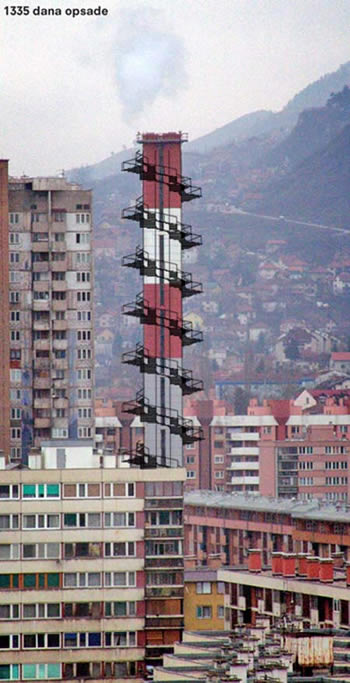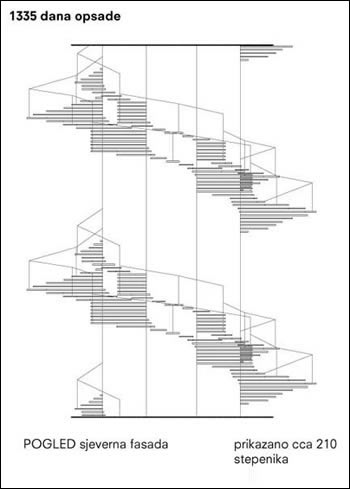Emir Haračić
Monument dedicated to the siege of Sarajevo is made out of 1335 stairs and has the mission to show person that climbs them the length and duration of hard and painful siege of Sarajevo. On the fence of the stairs there would be a ring for each victim of the siege – all together 10.000 rings. Monument to the siege of Sarajevo is made out of 1335 stairs – each step of the stairs stands for one day of the siege, 678 to climb up and 677 to come down (compared to the number of stairs that average 74-floor building would have). Each step of the stairs has 10 cm of height, but the width of the steps is different, focusing on avoiding normal climbing step – 2x height + 1x width=63 cm, which makes the steps very hard to climb up and come down (normal and average step height in construction is 17.5cm, and the width has to be equal). Stair walk has no place to rest (usually in architecture each resting point is placed after maximum of 18 steps, so it’s easier to climb them up).
Stair walk is divided in 2 spiral rows, each with the width of 80 cm, where the outside one is for climbing up, and the inner one for coming down. Each step is 80 cm of width, which is enough for one person to pass. This has the purpose to make impossible for the climber to come back in case he realizes at the middle point of climbing up, that it is too hard to climb it.
The climber that decides to climb the stairs up has to climb up all 1335 steps (like the people who stayed in Sarajevo during the siege had to go through all 1335 days of the siege).
During the climbing up and coming down the stairs, climbers have the opportunity to see the amazing view of Sarajevo. The highest step of the stairs is 68 meters above the earth, equivalent to 21 floors.
The fence on the sides of the stair walk is 85 cm high, which is 5 cm lower to the standard one, and is only made out of thin iron, so it doesn’t give the feeling of security to the person who decides to climb the stair walk.
Climbing these stairs with time starts to be a traumatic experience. Stairs are hard to climb, and each step we make to climb up we have to rethink (because each step had different width), so it feels as if there is no end, and it’s unsafe (but just seemingly). The climbers would be on big heights, exposed to the wind, without the possibility to come back.
On the fence of the stairs a ring is placed for each victim of the siege, where each step would have exact number of rings as the number of people killed that day – 10.000 rings all together. Minding the fact that stairs don’t look safe, the climber holds tight to the fence, feeling each ring. As the stairs get higher, the climber keeps on holding the fence stronger, and the rings are getting deeper and deeper into their hands.
On the entrance there would be a board with the statistical information related to the siege of Sarajevo.
The board on the exit would have the message: THIS IS JUST A STAIRWALK. THE SIEGE IS SOMETHING DIFFERENT. CONTINUE WALKING HAPPY THROUGH YOUR LIFE.
Project received for the competition for new monument/artwork in public space in the category “Interventions on existing monuments/ objects”.


